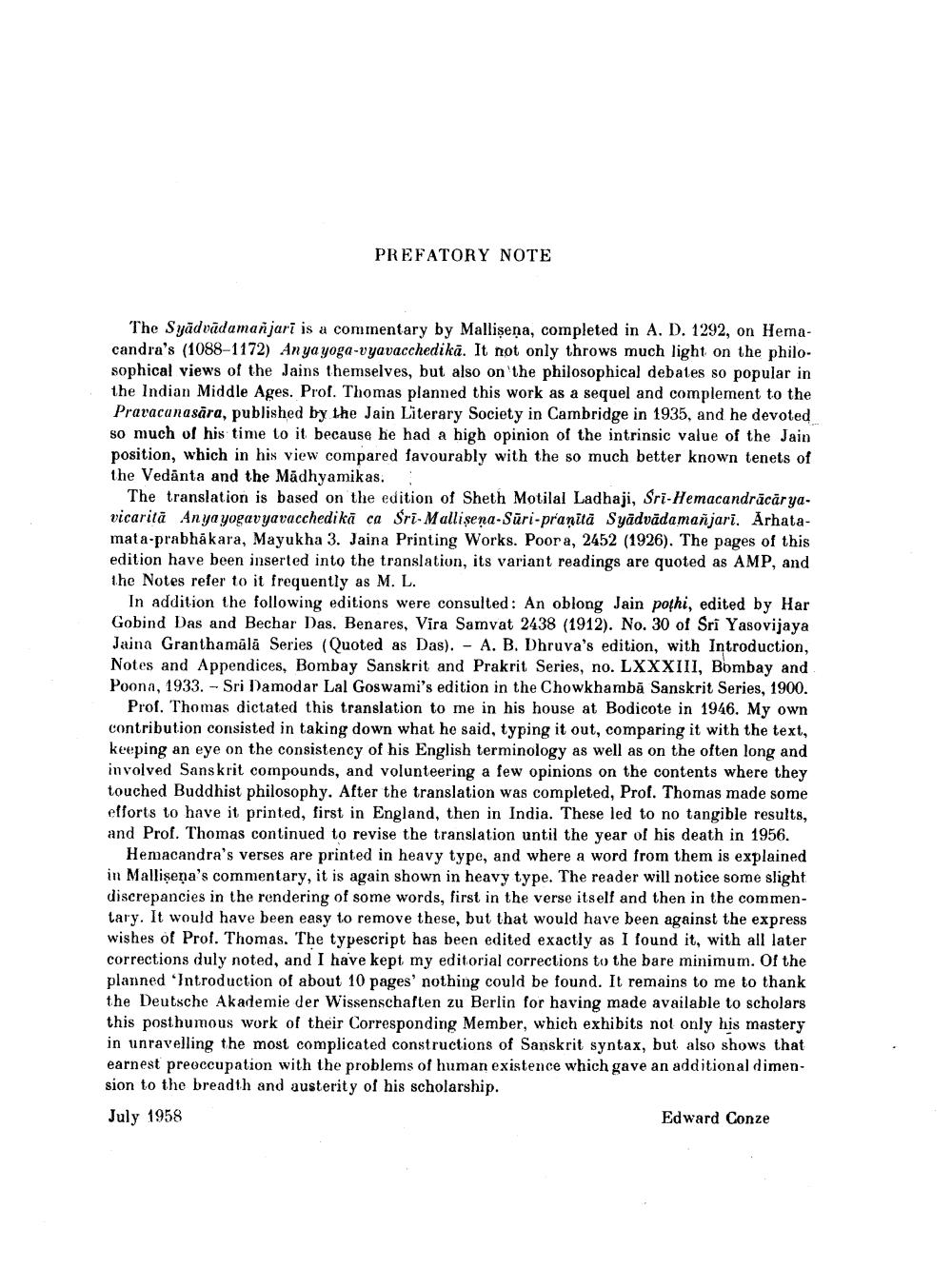Book Title: Syadvada Manjari Author(s): Mallishenacharya, F W Thomas Publisher: Motilal Banarasidas View full book textPage 4
________________ PREFATORY NOTE The Syädvādamañjari is a commentary by Mallisena, completed in A. D. 1292, on Hemacandra's (1088-1172) Anya yoga-vyavacchedikā. It not only throws much light on the philosophical views of the Jains themselves, but also on the philosophical debates so popular in the Indian Middle Ages. Prof. Thomas planned this work as a sequel and complement to the Praracanasāra, published by the Jain Literary Society in Cambridge in 1935, and he devoted so much of his time to it because he had a high opinion of the intrinsic value of the Jain position, which in his view compared favourably with the so much better known tenets of the Vedānta and the Mädhyamikas. : The translation is based on the edition of Sheth Motilal Ladhaji, Sri-Hemacandrācāryavicaritā Anya yogavyavacchedikā ca Śrī-Mallisena-Sūri-praạità Syādvādamañjari. Arhatamata-prabhākara, Mayukha 3. Jaina Printing Works. Poora, 2452 (1926). The pages of this edition have been inserted into the translation, its variant readings are quoted as AMP, and the Notes refer to it frequently as M. L. In addition the following editions were consulted: An oblong Jain pothi, edited by Har Gobind Das and Bechar Das. Benares, Vira Samvat 2438 (1912). No. 30 of Sri Yasovijaya Jaina Granthamäla Series (Quoted as Das). - A. B. Dhruva's edition, with Introduction, Notes and Appendices, Bombay Sanskrit and Prakrit Series, no. LXXXIII. Bombay and Poona, 1933. - Sri Damodar Lal Goswami's edition in the Chowkhamba Sanskrit Series, 1900. Prof. Thomas dictated this translation to me in his house at Bodicote in 1946. My own contribution consisted in taking down what he said, typing it out, comparing it with the text, keeping an eye on the consistency of his English terminology as well as on the often long and involved Sanskrit compounds, and volunteering a few opinions on the contents where they touched Buddhist philosophy. After the translation was completed, Prof. Thomas made some efforts to have it printed, first in England, then in India. These led to no tangible results, and Prof. Thomas continued to revise the translation until the year of his death in 1956. Hemacandra's verses are printed in heavy type, and where a word from them is explained in Mallişena's commentary, it is again shown in heavy type. The reader will notice some slight discrepancies in the rendering of some words, first in the verse itself and then in the commentary. It would have been easy to remove these, but that would have been against the express wishes of Prof. Thomas. The typescript has been edited exactly as I found it, with all later corrections duly noted, and I have kept my editorial corrections to the bare minimum. Of the planned 'Introduction of about 10 pages' nothing could be found. It remains to me to thank the Deutsche Akademie der Wissenschaften zu Berlin for having made available to scholars this posthumous work of their Corresponding Member, which exhibits not only his mastery in unravelling the most complicated constructions of Sanskrit syntax, but also shows that earnest preoccupation with the problems of human existence which gave an additional dimen. sion to the breadth and austerity of his scholarship. July 1958 Edward ConzePage Navigation
1 2 3 4 5 6 7 8 9 10 11 12 13 14 15 16 17 18 19 20 21 22 23 24 25 26 27 28 29 30 31 32 33 34 35 36 37 38 39 40 41 42 ... 178
